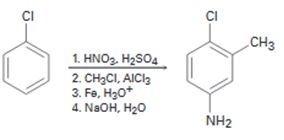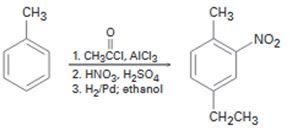
a)

Interpretation:
The flaw in the synthesis given is to be stated.
Concept introduction:
In aromatic electrophilic substitution reactions, alkyl groups are ortho and para directing and activating groups while
To state:
The flaw in the synthesis given.
b)

Interpretation:
The flaw in the synthesis given is to be stated.
Concept introduction:
In aromatic electrophilic substitution reactions, halogens are ortho and para directing groups. Friedal-Crafts alkylation is not possible with
To state:
The flaw in the synthesis given.
c)

Interpretation:
The flaw in the synthesis given is to be stated.
Concept introduction:
In aromatic electrophilic substitution reactions, alkyl groups are ortho and para directing and activating groups while carbonyl group is a meta directing and deactivating group. When treated with H2/Pd the –C=O group gets reduced to –CH2 group and –NO2 gets reduced to –NH2 group.
To state:
The flaw in the synthesis shown.
Trending nowThis is a popular solution!

Chapter 16 Solutions
Organic Chemistry
- Please devise syntheses of the product compounds below from their respective starting materials. Each of the synthesis will require multiple steps.arrow_forwardProvide a structure for the major products of the reactions and include the steps for each reaction.arrow_forward3 Propose a synthesis for the compounds below from benzene.arrow_forward
- Propose a synthesis for the following molecules, starting from benzene or a named variant.arrow_forwardComplete the following syntheses by filling in the missing structures or reagents! Thank you!arrow_forwardProvide the correct conditions and their major products for the two reactions below:arrow_forward
 Organic Chemistry: A Guided InquiryChemistryISBN:9780618974122Author:Andrei StraumanisPublisher:Cengage Learning
Organic Chemistry: A Guided InquiryChemistryISBN:9780618974122Author:Andrei StraumanisPublisher:Cengage Learning Organic ChemistryChemistryISBN:9781305580350Author:William H. Brown, Brent L. Iverson, Eric Anslyn, Christopher S. FootePublisher:Cengage Learning
Organic ChemistryChemistryISBN:9781305580350Author:William H. Brown, Brent L. Iverson, Eric Anslyn, Christopher S. FootePublisher:Cengage Learning


